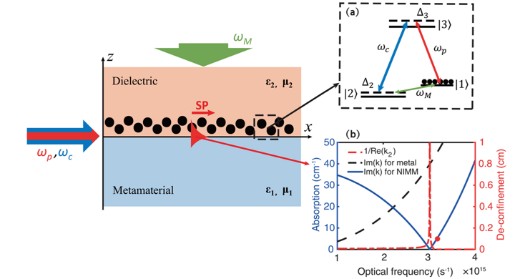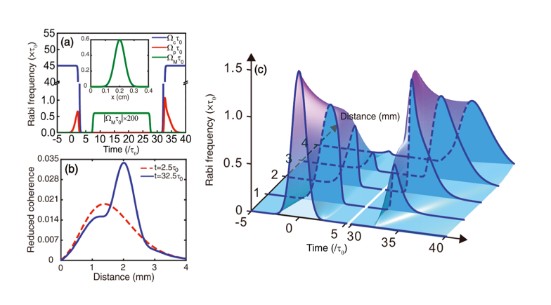ABSTRACT: We investigate the memory of a surface polariton (SP) via the electromagnetically induced transparency (EIT) of quantum emitters doped at the interface between a dielectric and a metamaterial. We show that, due to the strong mode confinement provided by the interface, the EIT effect can be largely enhanced; furthermore, the storage and retrieval of the SP can be realized by switching off and on a control laser field; additionally, the efficiency and fidelity of the SP memory can be much improved by using a weak microwave field. The results reported here are helpful not only for enhancing the understanding of the SP property but also for promising applications in quantum information processing and transmission.

Figure 1. Surface polaritons (SPs) excited at the interface of the NIMM (ε1, μ1) and the dielectric (ε2, μ2), propagating along the interface. The probe and control fields (with angular frequencies ωp and ωc, respectively) are incident along the interface (i.e., x direction). The microwave field (with angular frequency ωM) is incident from the .z direction. Inset: (a) Levels and excitation scheme of the Λ-type three-level quantum emitters (denoted by solid black dots); Δ3 (Δ2) is the one-photon (two-photon) detuning. (b) Absorption Im(k) of the SPs for the NIMM.dielectric interface (blue solid line) and for a metal.dielectric interface (black dashed line) and deconfinement 1/Re(k2) (red dashed line) as functions of optical oscillating frequency ωl. For suppressing four-wave mixing noise the initial population is prepared at the metastable state |1..

Figure 2. SP memory in the absence of a microwave field. (a) Dimensionless temporal profile of the control field (blue solid
line) and the SP field (red solid line) at position x = 2 mm. (b) Coherence of the quantum emitters, as a function of distance x at the time t1 = 2.5 (red dashed line) and t2 = 32.5 (blue solid line).(c) SP waveshape as a function of x and t during the storage andretrieval in the whole medium.

